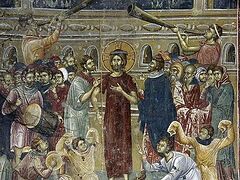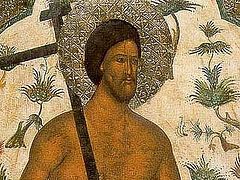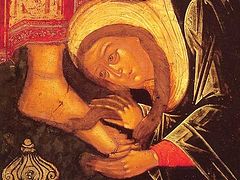On Palm Sunday, the people come out to greet our Lord Jesus Christ as He rides into Jerusalem on the back of a donkey.
Whereas God once spoke through Balaam’s donkey, here the beast bears the Hypostatic Word of God.
Christ comes on a donkey as a sign of His great humility. He comes not upon a chariot or mounted upon a regal steed, but upon a lowly donkey. He is alone, not at the head of a formidable army.
Therefore, the donkey also shows that Christ came in peace, not to conquer, as so many expected of Him at that time.
He is enthroned five days later, not upon the elevated seat of a worldly king, but upon the elevated Cross. We call Him King because we see Him crucified, says St. John Chrysostom.
However, though not a physical warrior, though He came in peace, the Lord is indeed a man of war—against spiritual wickedness. By His peace, by His humility, by His silence before His accusers, He is elevated upon the Cross, and His elevation is simultaneously His descent into the bowels of the earth, there to wage battle. There He ravages the kingdom of Satan and overthrows the dominion of sin and death.
And the people joyously greet the Lord waving palm branches and casting their garments down in His path.
Palm leaves are mentioned many times in Scripture and can have various meanings. According to Blessed Theophylact, palm branches were awarded to victors, here indicating that He Who resurrected Lazarus is victor over death. The victorious children of God who attain salvation are adorned with palm branches in the vision of St. John the Revelator (Rev. 7:9-17).
The Prophetess Deborah judged Israel from under a palm tree (Jdg. 4:4-5), and Christ enters the Holy City to enact His judgment over sin and death.
King Solomon adorned the Temple with carved figures of cherubim, flowers, and palm trees (1/3 Kg. 6:29-35), and as Christ tells us, His very Body is the true Temple (Jn. 2:19-21). Here the people hail their Temple with the branches that adorned the Temple of old.
Moreover, upon entering the city, Christ immediately goes to the Temple, where He shows Himself as Priest, carrying out an inspection of the building, as priests of Israel were commanded to do if a plague was suspected therein (Lev. 14). In fact, the Lord finds a spiritual leprosy; whereas Israelite priests would make everyone leave the house that it might be inspected, here Christ casts out the money changers—sinful men are the plague.
In Leviticus, the priest is to return a week later, and if he finds signs of plague on the walls of the house, he replaces those stones with new ones. And a week after Palm Sunday, on Holy Pascha, Christ raises up the Temple of His Body, thus replacing the leprous stones of the house on the Temple Mount.
When Christ returns to the Temple the day after His triumphal entry, He further examines the chief priests and elders and speaks to them of the stone which the builders rejected (Mt. 21:42).
On Palm Sunday, the people also greeted the coming Christ by casting their garments down to the ground before Him. This hearkens back to the garments of skin that God fashioned for Adam and Eve after their transgression.
Our first parents truly donned the skins of animals, but on a deeper level they fell to a lower state, against nature, and their flesh accordingly became denser, coarser, and inclined to sin.
Thus, the Jews greet their Savior, symbolically casting off these fallen garments, and Christ tramples them underfoot along His path, just as His Resurrection tramples down death, of which the garments of skin are an image.
The hymns of Holy Week make this very connection, though in reference to another Scriptural context:
The serpent found a second Eve in the Egyptian woman, and with words of flattery he sought to make Joseph fall. But, leaving his garments behind him, Joseph fled from sin; and like the first man before his disobedience, though naked he was not ashamed. At his prayers, O Christ, have mercy upon us (Holy Monday Matins, Aposticha).
Joseph fled the snare of fornication with Potiphar’s wife and maintained His purity.
But the parable of the foolish virgins shows us that this is not enough. Though foolish, they were virgins—always a sign of purity; but to refrain from defilement is, though laudable, but a beginning. They refrained from sin but neglected to fill their lamps with oil—to fill their souls with virtue.
And in this imagery, we are to see ourselves:
I slumber in slothfulness of soul, O Christ the Bridegroom; I have no lamp that burns with virtue, and like the foolish virgins I go wandering when it is time to act.
And yet, we are to maintain hope in the Lord:
Close not Thy compassionate heart against me, Master, but dispel dark sleep from me and rouse me up; and lead me with the wise virgins into the bridal chamber (Holy Tuesday Presanctified Liturgy, Stichera).
This descent into humility and ascent through hope mirrors the Lord’s own descent into the bowels of the earth followed by His glorious Resurrection.
This movement—humility and self-condemnation coupled with unwavering hope in the Lord—is characteristic of our entire liturgical tradition, broadly speaking. To confirm this, it is enough to look at the pre-Communion prayers, says Elder Zacharias of Essex.
The foolish virgins were locked out of the bridal chamber, but we hope to enter therein:
I see Thy bridal chamber adorned, O my Savior, and I have no wedding garment that I may enter there. Make the robe of my soul to shine, O Giver of Light, and save me (Bridegroom Matins, Exapostilarion).
In its prayers, the Church calls us to “keep our minds in hell and despair not.” This “charismatic despair” is a godly, not a worldly, sorrow (cf. 2 Cor. 7:9-11). We are unworthy of salvation, and yet the Lord is pleased to save us.
And today, Holy Thursday, the Disciples are led into the Bridal Chamber, partaking of the most intimate act of the Communion of the Body and Blood of the Lord Jesus Christ for the first time. And yet, the robe of the soul of Judas doesn’t shine, rather he is “stricken and darkened with the love of silver” (Holy Thursday Troparion).
And though the betrayer came to regret his deed, his was a not a godly sorrow, not a “charismatic despair,” but a worldly sorrow, unto his eternal damnation.
Unlike Judas, let us go out to meet Christ casting our fallen garments down for Him to trample; let us flee from all impurity like Joseph of old; let us keep our lamps trimmed and burning with the oil of the virtues, and thus we shall enter the bridal chamber and commune of the Body and Blood of the Bridegroom, ready to accompany Him to His enthronement upon the Cross.





